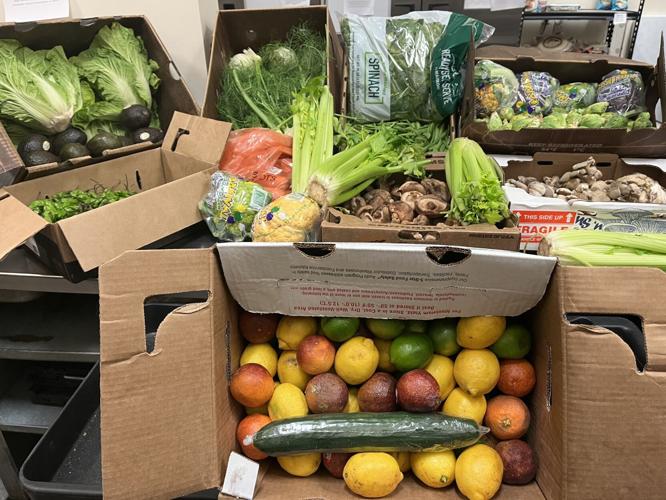The Paradise Paradox: In wealthy Summit County, hunger is soaring | Vince Bzdek
Summit County, home to four ski resorts, has some of the highest per capita income levels in the state.
The average household income is $131,395, nearly $51,000 above the U.S. average.
The median value of a home is $1,165,000, which is $761,000 above the U.S. average.
Yet on any given day, nearly one-fifth of Summit County locals don’t have enough to eat.
In the same place people pay as much as $225 for a one-day lift ticket to ski, the largest food pantry in Summit County has seen a 600% increase in demand since 2019, according to Diane Calvin, founder of CAFE Food Rescue.
Summit County now has eight different food bank programs doling out food to the hungry. On Thursday of last week, CAFE Food Rescue distributed 1,170 pounds of food in one day.
Smart Bellies, a program that delivers bags of staples to families and kids, is now serving 565 families and 1,150 kids weekly in Summit and Lake counties. Fifty-eight new families enrolled in just the past two weeks.
In six years, the Family and Intercultural Resource Center went from about 24 visits a day to its food market to more than 363 daily visits, according to reporting by the Summit Daily.
How is this possible? How can a place known for an annual flood of wealthy visitors, beautiful ski chalets, high-end boutiques and fairy-tale ambiance have such an acute problem with food insecurity? How can people afford to live in Summit County but not have enough money for food?
Mainly it’s because the cost of living and housing for locals has exploded in recent years, sucking up most of residents’ income. Grocery prices in Western states, including Colorado, increased by nearly 10% between January 2022 and January 2023, according to data from the U.S. Bureau of Labor Statistics, and food prices have stayed high even as inflation has come down.
The median home price in Summit County went up 30% in one year, from the middle of 2023 to the middle of 2024.
‘Tis the season to retell family stories that bind us together | Vince Bzdek
Breckenridge is now the third-most-expensive town with a population under 50,000 in America.
“People’s needs skyrocketed during COVID, and that hasn’t changed,” said Calvin. “You’ll find similar problems in Vail and Aspen.”
The phenomenon of desperately struggling workers in posh mountain towns has a name now: the paradise paradox. The “makers“ of a town’s allure — the locals who run the chairlifts, cook at the restaurants, build the houses, guide the river trips — are being overwhelmed by the “takers,“ wealthy newcomers who buy vacation homes and condos and drive up prices. As an area like Summit County becomes more popular, investors in short-term rentals like Airbnb and Vrbo compound the problem, and housing demand soon outstrips supply.
In recent years, the pandemic exacerbated affordability even further as well-off remote workers moved in.
To meet their basic needs, there are things locals absolutely have to pay, Calvin said. “They have to pay their rent or they don’t have a place to live. They have to put gas in the car or they can’t go to work. When they pay all these other things, like their health care, there’s no money left over for food.”
It’s also harder to make ends meet for most of the locals when the economy is so seasonal.
“There’s a lot of insecurity in the number of hours you might get, like if somebody comes here to clean hotels or to clean bed and breakfasts, they might not always get the number of hours they need to make ends meet,” said Calvin, especially in the off-seasons in spring and fall.
The average household income for people FIRC serves was $30,964 in 2022. That’s certainly above the federal poverty level of $22,290. But a family of four in Summit County needs to be making $98,064 to reach financial sustainability, according to a study of “self-sufficiency standards” by the Colorado Center on Law and Policy.
Summit County is also seeing record numbers of people enrolling for federal SNAP (Supplemental Nutrition Assistance Program) benefits, according to Janet Wolfson, who runs the economic security unit at the Department of Public Health. But many people in places like Summit County don’t qualify for SNAP benefits, because the aid is based on a national standard income, with a maximum of $39,000 for a family of four. Because of the high cost of living in Summit County, most wages are far higher than that cutoff, Calvin points out, so locals end up in a no-man’s land, where they need aid but don’t qualify for it.
The good news is that Summit County isn’t waiting for the federal government or the ski resort owners to solve this problem. The community has stepped up in an extraordinary, collaborative way to fill the gap.
CAFE Food Rescue, for one, just opened The Hub in Silverthorne on Oct. 24, a repurposed Pizza Hut with commercial-grade kitchen equipment, a walk-in refrigerator and freezer and tons of space for food repackaging. The spacious building is the county nerve center for collecting food and getting it to the people who need it most.
What Trump’s Cabinet picks say about his coming presidency | Vince Bzdek
CAFE Food Rescue recovers excess food from grocery stores, event centers, restaurants, cafes and caterers. “We have a whole network of partners that we work with in the community that distribute the food,” said Leanne Kelly, operations manager.
Board member Will Shira put it this way: “CAFE Food Rescue is important to Summit County, because it provides not only relief and stability to families but also other nonprofit groups in town that provide services. By working behind the scenes, we help people help people.”
Sometimes, CAFE Food Rescue takes recovered food right to a community dinner, such as the weekly Rotary Club dinner at the Elks Club for those in need.
“If that timing doesn’t work, we bring it here and then package it in smaller-size containers and put it at one of the food banks,” Kelly adds. They partner with Smart Bellies, Meals on Wheels, the Father Dyer Food Pantry, FIRC, Dillon Community Church Food Pantry, Summit Community Care Clinic, St. John’s Community Dinners, Rotary Community Dinners and their own food pantry.
Food rescue also eliminates a lot of waste.
CAFE Food Rescue volunteers regularly pick up food from Whole Foods for example, which has sell-by dates that are three or four days past the day food is packed and put out to sell. That food is still good for another two to three days after that, but Whole Foods would normally just throw it out. Instead, CAFE Food Rescue gets it repackaged and delivered quickly to families in need before it expires.
Calvin launched CAFE Food Rescue a few years ago as the sole worker, picking up and distributing food herself from the Keystone Conference Center. Most restaurants and catering companies didn’t have a good avenue to get surplus food to anyone before the nonprofit stepped in.
Calvin then discovered an extraordinary network of similarly concerned citizens in Summit County.
“Our community has one of the most cohesive networks of food and service providers that Food Bank of the Rockies knows about,” said Calvin. Since the pandemic, most of the food service providers have met every other week as part of the Summit Food Response Team. “It’s an informal network. We just get together every two weeks and talk about what’s happening — who’s seeing what.”
What‘s happening is skyrocketing need. By 2024, CAFE Food Rescue had grown to about 25 core volunteers who have already collected and distributed 100,000 pounds of food for the year.
The community has stepped up in supporting CAFE Food Rescue financially, as well.
A six-step plan for keeping Space Command in Colorado | Vince Bzdek
One-third of their support comes from local and county government grants, one-third is from local and state foundations, and the rest from individual donations from Summit County residents and from a host of visitors — no federal money at all.
Calvin has done presentations on their work for some of the wealthy visitors to Summit County and has opened their eyes and wallets.
“I think the need is going to continue to grow,” said Calvin. “I do believe that we have a wonderful community that cares about each other and that’s the reason we’ve been able to be so successful. That’s why what we’re doing works.
“We’re just floored by the need, though. We’re all struggling to try to make it up.”







